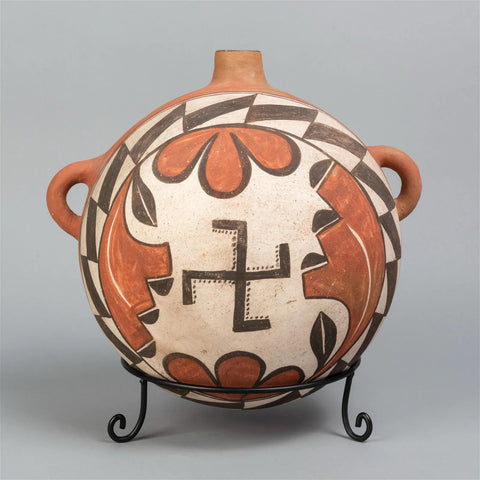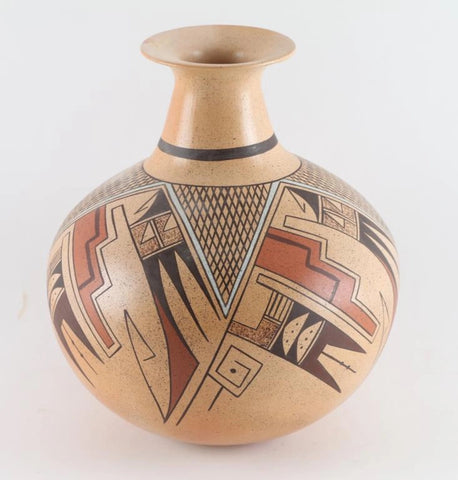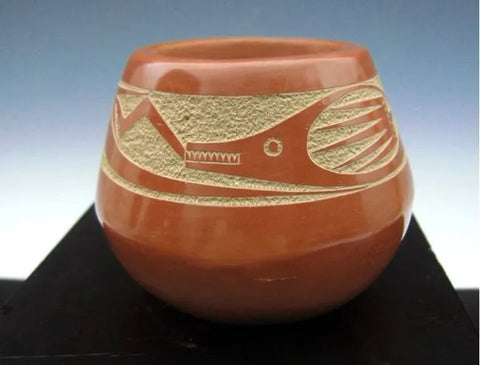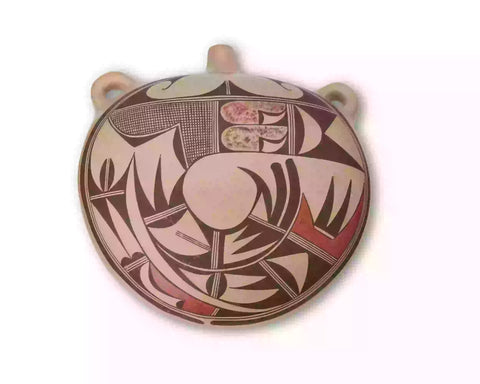
Native American Vintage Hopi Poly Chrome Pottery Tunyo Form Jar by Dee Setalla, #1435 Sold
$ 5,243.00
Native American Vintage Hopi Poly Chrome Pottery Tunyo Form Jar by Dee Setalla, #1435
Description: #1435 Native American Vintage Hopi Poly Chrome Pottery Tunyo Form Jar by Dee Setalla. Here is what Dee has to say about the piece. Dee Setalla "Thank you for posting this beautiful pot. I really enjoyed building this pot from the beginning to the end. Designs on the pottery are the Spirit corn for blessings , Earth Mother which is the protector , Bear claws is healing, turkey feathers for prayers. At the top portion step like would be your dark clouds with white migration for good life and purification , followed by your water waves is life. At the very bottom part of pot would be water waves for good life throughtout the world. The designs I paint on my potteries all signify spiritual prayers and good blessings. Different potters have there own interpetations of explaining there designs , this is the meaning of my designs. Building the pot and painting it all comes from my heart and the great help of my ancestors !"
Dimensions:Height 9 1/2 inches x depth 13 inches
Condition: Excellent for its age
Provenance: Property from the Collection of Joan and Ron Harris Jackson, Wyoming
"Dee Setalla, Hopi Pueblo, is a son of Pauline Setalla brother of Gwen Setalla, Agnes Nahsonhoya, Stetson Setalla, Justina Setalla and Karen Namoki. Nephew of Fawn Navasie. He is therefore in the Frog Woman and Feather Woman families. He credits his mother for teaching him not only how to form and decorate a vessel but for the proper respect for Mother Nature when gathering clay. He strongly believes that when working with clay, the potter is bringing to life a new being and it must be respected and nurtured. Many of the older potters hold such beliefs, but it is interesting to see that a younger generation can have such feelings as well". Reference: Hopi-Tewa Pottery: 500 Artist Biographies by Gregory Schaaf. (Source: adobe Gallery)
“Pueblo pottery is made using a coiled technique that came into northern Arizona and New Mexico from the south, some 1500 years ago. In the four-corners region of the US, nineteen pueblos and villages have historically produced pottery. Although each of these pueblos use similar traditional methods of coiling, shaping, finishing and firing, the pottery from each is distinctive.
Various clay's gathered from each pueblo’s local sources produce pottery colors that range from buff to earthy yellows, oranges, and reds, as well as black. Fired pots are sometimes left plain and other times decorated—most frequently with paint and occasionally with applique. Painted designs vary from pueblo to pueblo, yet share an ancient iconography based on abstract representations of clouds, rain, feathers, birds, plants, animals and other natural world features.
Tempering materials and paints, also from natural sources, contribute further to the distinctiveness of each pueblo’s pottery. Some paints are derived from plants, others from minerals. Before firing, potters in some pueblos apply a light colored slip to their pottery, which creates a bright background for painted designs or simply a lighter color plain ware vessel. Designs are painted on before firing, traditionally with a brush fashioned from yucca fiber.
Different combinations of paint color, clay color, and slips are characteristic of different pueblos. Among them are black on cream, black on buff, black on red, dark brown and dark red on white (as found in Zuni pottery), matte red on red, and poly chrome—a number of natural colors on one vessel (most typically associated with Hopi). Pueblo potters also produce undecorated polished black ware, black on black ware, and carved red and carved black wares.
Making pueblo pottery is a time-consuming effort that includes gathering and preparing the clay, building and shaping the coiled pot, gathering plants to make the colored dyes, constructing yucca brushes, and, often, making a clay slip. While some Pueblo artists fire in kilns, most still fire in the traditional way in an outside fire pit, covering their vessels with large potsherds and dried sheep dung. Pottery is left to bake for many hours, producing a high-fired result.
Today, Pueblo potters continue to honor this centuries-old tradition of hand-coiled pottery production, yet value the need for contemporary artistic expression as well. They continue to improve their style, methods and designs, often combining traditional and contemporary techniques to create striking new works of art.” (Source: Museum of Northern Arizona).
-----------
View the other items in my shop: http://www.etsy.com/shop/CulturalPatina?ref=shopsection_shophome_leftnavDescription:
Description: #1435 Native American Vintage Hopi Poly Chrome Pottery Tunyo Form Jar by Dee Setalla. Here is what Dee has to say about the piece. Dee Setalla "Thank you for posting this beautiful pot. I really enjoyed building this pot from the beginning to the end. Designs on the pottery are the Spirit corn for blessings , Earth Mother which is the protector , Bear claws is healing, turkey feathers for prayers. At the top portion step like would be your dark clouds with white migration for good life and purification , followed by your water waves is life. At the very bottom part of pot would be water waves for good life throughtout the world. The designs I paint on my potteries all signify spiritual prayers and good blessings. Different potters have there own interpetations of explaining there designs , this is the meaning of my designs. Building the pot and painting it all comes from my heart and the great help of my ancestors !"
Dimensions:Height 9 1/2 inches x depth 13 inches
Condition: Excellent for its age
Provenance: Property from the Collection of Joan and Ron Harris Jackson, Wyoming
"Dee Setalla, Hopi Pueblo, is a son of Pauline Setalla brother of Gwen Setalla, Agnes Nahsonhoya, Stetson Setalla, Justina Setalla and Karen Namoki. Nephew of Fawn Navasie. He is therefore in the Frog Woman and Feather Woman families. He credits his mother for teaching him not only how to form and decorate a vessel but for the proper respect for Mother Nature when gathering clay. He strongly believes that when working with clay, the potter is bringing to life a new being and it must be respected and nurtured. Many of the older potters hold such beliefs, but it is interesting to see that a younger generation can have such feelings as well". Reference: Hopi-Tewa Pottery: 500 Artist Biographies by Gregory Schaaf. (Source: adobe Gallery)
“Pueblo pottery is made using a coiled technique that came into northern Arizona and New Mexico from the south, some 1500 years ago. In the four-corners region of the US, nineteen pueblos and villages have historically produced pottery. Although each of these pueblos use similar traditional methods of coiling, shaping, finishing and firing, the pottery from each is distinctive.
Various clay's gathered from each pueblo’s local sources produce pottery colors that range from buff to earthy yellows, oranges, and reds, as well as black. Fired pots are sometimes left plain and other times decorated—most frequently with paint and occasionally with applique. Painted designs vary from pueblo to pueblo, yet share an ancient iconography based on abstract representations of clouds, rain, feathers, birds, plants, animals and other natural world features.
Tempering materials and paints, also from natural sources, contribute further to the distinctiveness of each pueblo’s pottery. Some paints are derived from plants, others from minerals. Before firing, potters in some pueblos apply a light colored slip to their pottery, which creates a bright background for painted designs or simply a lighter color plain ware vessel. Designs are painted on before firing, traditionally with a brush fashioned from yucca fiber.
Different combinations of paint color, clay color, and slips are characteristic of different pueblos. Among them are black on cream, black on buff, black on red, dark brown and dark red on white (as found in Zuni pottery), matte red on red, and poly chrome—a number of natural colors on one vessel (most typically associated with Hopi). Pueblo potters also produce undecorated polished black ware, black on black ware, and carved red and carved black wares.
Making pueblo pottery is a time-consuming effort that includes gathering and preparing the clay, building and shaping the coiled pot, gathering plants to make the colored dyes, constructing yucca brushes, and, often, making a clay slip. While some Pueblo artists fire in kilns, most still fire in the traditional way in an outside fire pit, covering their vessels with large potsherds and dried sheep dung. Pottery is left to bake for many hours, producing a high-fired result.
Today, Pueblo potters continue to honor this centuries-old tradition of hand-coiled pottery production, yet value the need for contemporary artistic expression as well. They continue to improve their style, methods and designs, often combining traditional and contemporary techniques to create striking new works of art.” (Source: Museum of Northern Arizona).
-----------
View the other items in my shop: http://www.etsy.com/shop/CulturalPatina?ref=shopsection_shophome_leftnavDescription:
Related Products
Sold out




